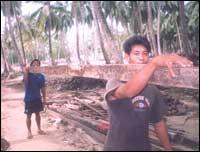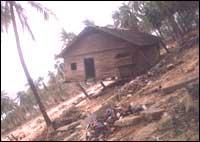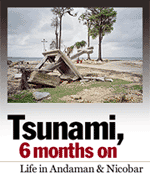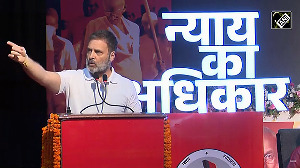Contributing Special Correspondent A Ganesh Nadar reports from Harminder Bay. The second in a series on life in the Andaman and Nicobar islands, six months after the tsunami.
Simeon Joshua likes beginning his sentences with the word, 'Only'. He uses it a lot. A young Nicobaree volunteer with Aparajita, the most visible NGO in Little Andaman, he says he gets "Only Rs 2,000 a month for this work." The work in question is eradication.Part I: How the IAF set up CarNic Airbase again
For Rs 2,000 a month, Simeon works to eliminate all traces of nature's fury. Marks created on December 26 by that infamous tsunami. India's sentinels -- the Andaman and Nicobar islands -- were the first to face the tidal waves in India. From North to South, 652 islands stretching over 650 kilometres took on Mother Nature. And lost. The destruction was total; the landscape, barren.
Six months later, we have come to pick up the threads of that story.
We are at Harminder Bay, Little Andaman, a camp for local Nicobaree tribals. The government death count here is less than a hundred. The actual number will never be revealed though, simply because the exact number of tribals is unknown.
 Standing before us, Simeon (left) instructs four boys on the shop he wants painted today. He pays them Rs 300 per shop. Yoriel, one of the boys working for Simone during his school holidays, is employed twice a week. The four boys paint four shops a day. They use bright red paint, so you can pinpoint shops across the island.
Standing before us, Simeon (left) instructs four boys on the shop he wants painted today. He pays them Rs 300 per shop. Yoriel, one of the boys working for Simone during his school holidays, is employed twice a week. The four boys paint four shops a day. They use bright red paint, so you can pinpoint shops across the island.
Apart from the painting, Simeon's duties include distributing medicine and forming self-help groups. The groups, comprising farmers, are currently working on saving money by selling dried coconuts and betel nuts.
Simeon tells us he has studied up to Class 12. He takes us around the temporary shelter they have built themselves, with material given by the government and a daily salary of Rs 107. The flooring is bad. It has not been cemented, so big, strong machaans made of coconut logs are used instead.
He says they had asked the administration for timber, but that didn't happen. So, they live in shelters built of corrugated iron sheets. It has rained heavily and the floor is slushy. Every home has mosquito nets, gas and fans. There is electricity in the streets, but the homes have yet to receive power.
What about water, we ask. "Only one hour-and-a-half the water comes in a day," comes the reply. Water is pumped here from a waterfall on the other side of the island. Walking through Simeon's village, we find nothing. It was forsaken. Lost completely. The waves had carried away everything, leaving behind desolation. Six months on, only one house stands, tilted on its side. A few ovens used to dry coconuts lie around, the only signs that humans once inhabited the place.
***
Nahemia Vensaaz and Janardhan Lucas (alongside) roam around the erstwhile village, collecting logs for their fireplace. For those in need of  firewood, the tsunami has provided plenty. Nahemia and Janardhan know the latest Hindi film songs. Humming a track from last year's Shah Rukh Khan starrer Main Hoon Na, they show us the well that had supplied the village with drinking water. Seawater has taken over. The water is still salty. Simeon points to the remains of the sea wall. Only 1/100th of it remains.
firewood, the tsunami has provided plenty. Nahemia and Janardhan know the latest Hindi film songs. Humming a track from last year's Shah Rukh Khan starrer Main Hoon Na, they show us the well that had supplied the village with drinking water. Seawater has taken over. The water is still salty. Simeon points to the remains of the sea wall. Only 1/100th of it remains.
Back at camp, we meet Samson Lazarus, who used to have a shop in the village. He has now set up shop at camp, buying in Hut Bay and selling it here. The rest of his family is involved in coconut farming.
Simeon is sad about the fact that there are no activities for camp inmates. The Class 10 and 12 children have left for Port Blair to appear for exams. The other children study in temporary classes within camp. They have no games. They love football, cricket and volleyball, but have nothing to play them with. They love music, but have no instruments. What Simeon particularly wants is an electric guitar.
Soon after the tsunami struck, the government and NGOs concentrated on food, clothes and homes. Games to keep children happy were not high on any priority list.
Victims are soon to move into intermediate shelters, which are supposedly stronger, spacious and higher. But they have the same iron sheets that the tribals don't like. The floors are not cemented, which means the slush will prevail. Permanent settlements appear a distant two years away.
This tilted house below is the only one which survived the fury of tsunami waves in the village.
 Simeon says he will marry three years from now, when he turns 30. There is sorrow in his eyes, but not in his speech. Sorrow exists in all their eyes. But the smiles never leave their faces. They survive on free rations provided by the administration -- 15 kgs per adult per month, with dal, oil, spices, salt, kerosene, cooking oil and gas.
Simeon says he will marry three years from now, when he turns 30. There is sorrow in his eyes, but not in his speech. Sorrow exists in all their eyes. But the smiles never leave their faces. They survive on free rations provided by the administration -- 15 kgs per adult per month, with dal, oil, spices, salt, kerosene, cooking oil and gas.
Nature has spoken. The government is trying its best, hampered by the monsoon and the distance from the mainland. There are no industries here, so even nails have to be brought in from the mainland. Debris is yet to be cleared. In the harbour, the passenger jetty stands useless. The breakwater wall has been broken. Luckily, the cargo jetty survived.
Simeon waves goodbye. He asks about our next trip, saying, "Don't forget that electric guitar."
Photographs: A Ganesh Nadar







 © 2025
© 2025